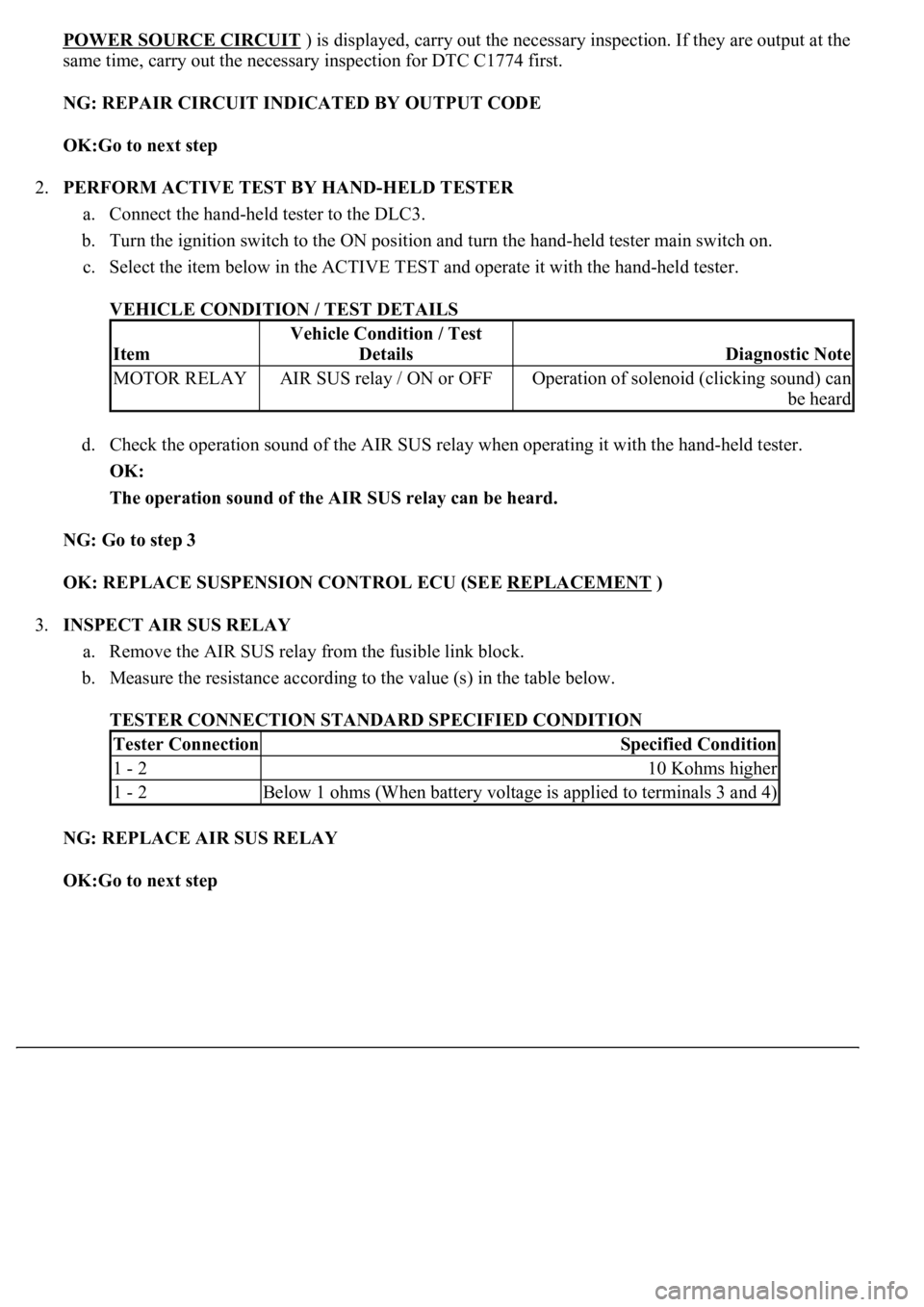Page 566 of 4500
<0029004c004a00110003001b0017001d0003002c0047004800510057004c0049005c004c0051004a000300350048004400550003002b0048004c004a004b00570003002600520051005700550052004f000300360052004f004800510052004c0047000300
390044004f0059004800030026005200510051004800460057[or Terminals
Courtesy of TOYOTA MOTOR SALES, U.S.A., INC.
NG: REPAIR OR REPLACE HARNESS OR CONNECTOR
OK: REPLACE SUSPENSION CONTROL ECU (SEE REPLACEMENT
)
CIRCUIT DESCRIPTION
The signal from the suspension control ECU switches the AIR SUS relay on, and then the height control
compressor motor starts.
Page 568 of 4500

POWER SOURCE CIRCUIT ) is displayed, carry out the necessary inspection. If they are output at the
same time, carry out the necessary inspection for DTC C1774 first.
NG: REPAIR CIRCUIT INDICATED BY OUTPUT CODE
OK:Go to next step
2.PERFORM ACTIVE TEST BY HAND-HELD TESTER
a. Connect the hand-held tester to the DLC3.
b. Turn the ignition switch to the ON position and turn the hand-held tester main switch on.
c. Select the item below in the ACTIVE TEST and operate it with the hand-held tester.
VEHICLE CONDITION / TEST DETAILS
d. Check the operation sound of the AIR SUS relay when operating it with the hand-held tester.
OK:
The operation sound of the AIR SUS relay can be heard.
NG: Go to step 3
OK: REPLACE SUSPENSION CONTROL ECU (SEE REPLACEMENT
)
3.INSPECT AIR SUS RELAY
a. Remove the AIR SUS relay from the fusible link block.
b. Measure the resistance according to the value (s) in the table below.
TESTER CONNECTION STANDARD SPECIFIED CONDITION
NG: REPLACE AIR SUS RELAY
OK:Go to next step
Item
Vehicle Condition / Test
Details
Diagnostic Note
MOTOR RELAYAIR SUS relay / ON or OFFOperation of solenoid (clicking sound) can
be heard
Tester ConnectionSpecified Condition
1 - 210 Kohms higher
1 - 2Below 1 ohms (When battery voltage is applied to terminals 3 and 4)
Page 572 of 4500
Fig. 90: Identifying Air Sus Relay Location
Courtesy of TOYOTA MOTOR SALES, U.S.A., INC.
NG: REPAIR OR REPLACE HARNESS OR CONNECTOR
OK: REPLACE SUSPENSION CONTROL ECU (SEE REPLACEMENT
)
CIRCUIT DESCRIPTION
The signal from the suspension control ECU turns on the AIR SUS relay. At that time, battery voltage is input
to the height control compressor motor through the AIR SUS relay. The height control compressor motor starts.
<0029004c004a00110003001c0014001d0003002700370026000300260014001a001700150003002700480057004800460057004c0051004a00030026005200510047004c0057004c005200510003002400510047000300370055005200580045004f004800
030024005500480044[
Page 574 of 4500
HINT:
If DTC C1741 (AIR SUS relay circuit) is displayed, carry out the inspection necessary (SEE DTC C1741
AIR SUS RELAY CIRCUIT ).
NG: REPAIR CIRCUIT INDICATED BY OUTPUT CODE
OK:Go to next step
2.INSPECT HEIGHT CONTROL COMPRESSOR MOTOR
a. Disconnect the height control compressor motor connector.
b. Connect terminal 1 (B) to the battery positive (+) terminal, and terminal 2 (E) to the battery
negative (-) terminal.
c. Check the operating sound of the compressor motor.
OK:
Compressor motor operates.
HINT:
When a malfunction is found in the height control compressor motor, replace the height control
compressor assy.
NG: REPLACE HEIGHT CONTROL COMPRESSOR ASSY (SEE REPLACEMENT
)
OK:Go to next step
Page 585 of 4500
RESULT DESCRIPTION
HINT:
When a malfunction is found in the rear solenoid valve, replace the height control valve sub-assy No. 2.
B: REPLACE HEIGHT CONTROL VALVE SUB-ASSY NO. 1 (SEE REPLACEMENT
)
C: REPLACE HEIGHT CONTROL VALVE SUB-ASSY NO. 2 (SEE REPLACEMENT
)
A:Go to next step
Fig. 102: Identifying Height Control Solenoid Valve Rear LH Connector Terminals
Courtesy of TOYOTA MOTOR SALES, U.S.A., INC.
9.INSPECT EXHAUST SOLENOID VALVE
a. Disconnect the exhaust solenoid valve connector.
b. Connect terminal 1 (SLEX) to the battery positive (+) terminal, and terminal 2 (GND) to the battery
ne
gative (-) terminal.
OKA
NGC
Page 586 of 4500
c. Check the operating sound of the exhaust solenoid valve.
OK:
It should make an operating sound (click).
HINT:
When a malfunction is found in the exhaust solenoid valve, replace the height control compressor assy.
NG: REPLACE HEIGHT CONTROL COMPRESSOR ASSY (SEE REPLACEMENT
)
OK:Go to next step
Fig. 103: Identifying Exhaust Solenoid Valve Connector Terminals
Courtesy of TOYOTA MOTOR SALES, U.S.A., INC.
Page 587 of 4500
10.INSPECT FOR CLOGGED AIR TUBE
a. Check the air tube visually for a clog or damage (see ON
-VEHICLE INSPECTION ).
OK:
Air tube is not clogged or damaged.
NG: REPAIR OR REPLACE AIR TUBE
OK: REPLACE SUSPENSION CONTROL ECU (SEE REPLACEMENT
)
CIRCUIT DESCRIPTION
The signal from the suspension control ECU operates the AIR SUS relay and the height control compressor
motor starts.
The height control compressor motor operates until the targeted vehicle height is reached. Then the height
control sensor sub-assy sends the signal to the suspension control ECU, and stops the height control compressor
motor.
Fig. 104: DTC C1751 And DTC C1752 Detecting Condition And Trouble Area
Courtesy of TOYOTA MOTOR SALES, U.S.A., INC.
INSPECTION PROCEDURE
1.CHECK HEIGHT CONTROL COMPRESSOR CIRCUIT (SEE DTC C1742 HEIGHT
CONTROL COMPRESSOR CIRCUIT )
2.CHECK AIR LEAKAGE (SEE ON
-VEHICLE INSPECTION )
OK:
No leaks
Page 592 of 4500
Fig. 108: Identifying Height Control Solenoid Valve Rear LH Connector Terminals
Courtesy of TOYOTA MOTOR SALES, U.S.A., INC.
RESULT DESCRIPTION
HINT:
When a malfunction is found in the rear solenoid valve, replace the height control valve sub-assy No. 2.
B: REPLACE HEIGHT CONTROL VALVE SUB-ASSY NO. 1 (SEE REPLACEMENT
)
C: REPLACE HEIGHT CONTROL VALVE SUB-ASSY NO. 2 (SEE REPLACEMENT
)
A:Go to next step
5.INSPECT EXHAUST SOLENOID VALVE
a. Disconnect the exhaust solenoid valve connector.
b. Connect terminal 3 (SLEX) to the battery positive (+) terminal, and terminal 2 (GND) to the battery
ne
gative (-) terminal.
OKA
NGC